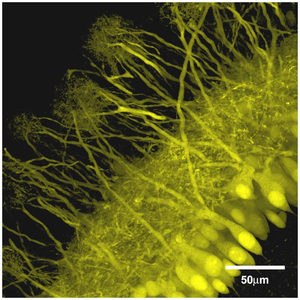Deciphering Scent: How We Untangle the Tapestry of Odors

Walk into a diner around breakfast time, and you’re likely to be hit with an array of enticing odors — steaming coffee, freshly baked muffins, bacon sizzling on the grill. Given that each of these smells is made up of a mix of different volatile compounds all hitting our olfactory system at the same time, how does our brain discern the identity of the different foods?
The problem is particularly challenging given the structure of our olfactory system. Mammals have about 1,000 different olfactory receptors, each of which can detect a single chemical. But we can identify thousands of smells, meaning we know more odors than we have measurements for.
Most experimental and theoretical studies of the olfactory system simplify the question by studying odors one at a time, says Alexandre Pouget, a computational neuroscientist at the University of Geneva and an investigator with the Simons Collaboration on the Global Brain. But our olfactory reality is much more complex. Mole, a traditional Mexican sauce, might have more than 20 different ingredients, and a talented chef can pick them out. The forest floor is littered with layers of scent, yet a bloodhound can track a target for miles.
In research published in Nature Neuroscience in December 2016, Pouget and his collaborators developed an algorithm that shows how the olfactory system might identify individual odors in an environment with multiple smells. Their procedure uses a combination of ‘predictive coding’ and prior information.
Predictive coding refers to the idea that the brain interprets sensory information using models it generates from memory and the current context. In other words, the brain doesn’t just analyze the new data it perceives; it generates predictions about those data. The smells of coffee, muffins and bacon will activate a certain pattern in the olfactory receptor neurons. According to the model from Pouget and his collaborators, that information is transferred to the cortex, which generates a theory about the individual components of the olfactory mix. It predicts the pattern those components would generate in olfactory receptor neurons and sends that prediction back to the mitral cells of the olfactory bulb. These cells compare the predicted pattern with reality.
“Mitral cells are in a perfect position to compare what olfactory neurons say to the prediction the brain generates,” Pouget says. If the two patterns match, the cortex correctly guessed the ingredients in the olfactory mix. If there’s a mismatch, the mitral cells relay the error to the cortex, which revises its hypothesis.
To further constrain the problem, researchers give the system some prior information — most olfactory scenes are composed of just three to four odors. Guesses with hundreds or thousands of odors are then given low probability. “That’s the new twist in our approach; the brain comes up with the most likely explanation for an olfactory scene given current information and prior knowledge of natural statistics,” Pouget says.
The researchers next want to understand how the system learns. “How do you know when you’re in an environment where you need to create a new representation for a new odor?” Pouget says. “If I give the system a novel odor, it will interpret it as a mix of known odors. But if you get exposed over and over to the new odor, you eventually recognize it as something different. We don’t know how that process works.”
Pouget, a wine lover, also wants to apply the algorithm to the science of wine. In principle, properly trained networks could recognize the components of a wine and perhaps predict how the wine will age. Knowing just when to open a prized bottle is certainly cause for celebration.


